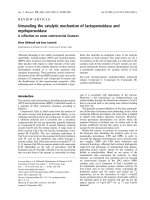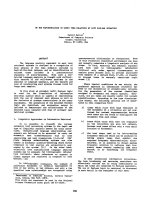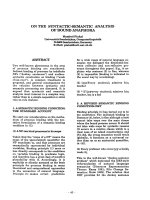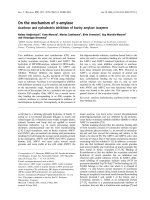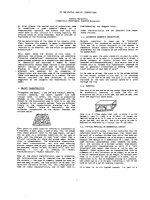Báo cáo khoa học: "ON THE SPATIAL USES OF PREPOSITIONS" docx
Bạn đang xem bản rút gọn của tài liệu. Xem và tải ngay bản đầy đủ của tài liệu tại đây (424.24 KB, 6 trang )
ON THE SPATIAL USES OF PREPOSITIONS
Annette Herskovlts
Linguistics Department, Stanford University
At
first glance, the spatial uses of prepositions seem
to constitute a good semantic domain for a
computational approach. One expects such uses will
refer more or less strictly to a closed, explicit, and
precise chunk of world knowledge. Such an attitude Is
expressed in the following statement:
"Given descriptions of the shape of two objects, given
their location (for example, by means ox coordinates in
Some system of reference), and, In some cases, the
location of an observer, one can select an appropriate
preposition."
This paper shows the fallacy of this claim.
It
addresses the problem of interpreting and generating
"locative predications" (expressions made up of two
noun-phrases governed by a preposition used spatially).
It
identifies and describes a number of object
characteristics beyond shape (section I) and contextual
factors (section 2) which bear on these processes.
Drawing on these descriptions, the third section
proposes core meanings for
two
categories of
prepositions, and describes some of the transfor~ttons
these core meanings are subject to in context. The last
section outlines the main directions of Inquiry
suggested by the examples and observations in the
paper.
1. ~BJECT CHARACTERISTIC~
Throughout the paper, I use the term "object ~, meaning,
strictly speaking, the object together with some
lextcal label. In effect, the choice of preposition
depends on the lexical category associated with the
object by the noun-phrase used to refer to It. And such
a category is not uniquely defined. There are different
levels In the categorization hierarchy (e.g. "end
table", "table", "piece of furniture'), but also
different perspectives on the object. Consider the
picture below.
,~, , ~,
That patch of grass could be referred to alternately as
a front.yard, a larun, grass, a patch of pass,
etc. (to assume
that these phrases refer to the sane object, one must
see
the grass
as a metonymlc substitute for
tMs patcA of
grass,
and the
front.yard
as some "area" rather than a
"slice" lncludln~ air above and ground under; neither
view is unreasonable). The permissible prepositions,
and
their interpretation, vary
with
each referring
phrase: compare
in/on the ~ass, ~nion tA~ patcA of ~as~, inK*on)
tan
front.~:rd, onl(*~n) the /reran
[Fillmore 1971]. With this
warning, I will go on speaking of "object
characteristics', "object identity", etc.
Some of the object characteristics used in production
and interpretation can be computed from the shape of
the objects the axes of symmetry (needed for across tan
road
and
along
tan
ro~d),
the "top
surface"
(on
t&e label),
the
~outllne" (tA, #ird in t~ tree), etc. (for a description of
some of these
characteristics,
and of
their
role
In
comprehension, see [Boggess 1979]).
Other characteristics are not deducible from shape.
These include:
1.
1,
ALTERNATE GEOM~'I'RIC DESCRIPTIONS
Objects identical in shape may be "conceived m
differently, for instance as surface or as enclosure.
This may be a choice available to the speaker to
emphasize certain aspects
(inlon t~$e
rug), or It may be
determined for the category of the reference object (on
tAe football field).
In
under
t/te
aJater,
the water stands for tAe upper
free surface
of
tAn
ruater;
in
in
the
water,
it
.is conceived as a volume. A
whole category of objects follows this rule: see
(undtrlln) tan (snowllakeloceanlsan41.).
Such objects tend to be
viewed only as volumes with "underneath':
undcrn~A fat
lake
is generally interpreted as meaning "under the
lower surface of that body of water'.
In
tan crack In tan 6~wl,
the crack Is In the volume defined
by the normal surface of the bowl in Its uncracked
state. In
tan milk
in tat
bowl,
the milk Is In the volume
enclosed by the bowl and limited upward by a plone
through the rim.
1.2. FUNCTION
One says
in ran disk
and
on the tray
though these objects uy
be essentially Identical in shape. One will not
ordinarily say
tan cat Is in :At t~e,
but
un~r tan t~e,
even
with the cage-like table below.
/oAn is et X
Often means that John Is using I as one
normally uses it
(JoAn is at his desk).
If normal use
implies being on or m X, then at Is not used (John is in
or on the bed, but not at). And to the right of the chadr Is
defined by reference to a typical user of the chair.
1.3. TYPICAl, PHYSICAl, OR GEOMETRICAL CONTEXT
When using
in
with areas, it Is not sufficient that the
reference object be two-dimensional; that object must
be part of a surface divided into cells. One does not
draw a line
in a blackboard;
but
in
tat
nlargin
is acceptable,
because the margin is a subdivision of a page. In the
same fashion, ' geographical areas
(England, tat county,
etc.) are sections of a divided surface. Some objects
are exclusively conceptualized as parts of a "cell
structure" and cannot then follow at (*at his room, *at
England).
Other objects can be conceptualized both as
elements of a cell structure
(in the village),
or as one of
a set of separate places
(at tat ~illage).
Or consider ~ard:
when 1~ is a part of the grounds of a house, one is
restricted to In. But of somebody working In a Junkyard,
one could say
he is at the )¢rd,
reflecting a view of the
yard as one of a set of separate locations.
If a door is in its typical context, i.e. part of a
wall, then interpretation of m tk~ right
of Me d~r
must be
based on the door's own axes. Otherwise (In a hardware
store for example) an observer's line of sight my
override the door's cross-axis.
1.4. RELATIVE MOBILITY
The mobility of the reference object relative to the
located object influences the order of the nominals
around the preposition: the more mobile object normally
precedes the preposition. One will not say t/ur ~&,n~ bot~t
i~ tam one in a cap, but tke one ~dk a ~p on it. Following
Tally
(1978a],
I will call
the located object the "Figure",
and
the reference object the "Ground", when discussing
the order of the nominals.
Human beings tend to play havoc with the relative
mobility rule, either because they are the preferred
topic (flee man i~ a Nu~ coat), or as center of the
universe preferred reference object (tke EmpOe 3t~e
building i~ in front of me).
Typicality plays an ilportant role in deterllnlng an
appropriate locative predication (and no doubt other
types of expressions). The choice of expression tends
to depend not on particular (non prototypicaI)
attributes of the objects considered, but rather on
typical attributes of the category to which they are
assigned by the linguistic expression. If typical
conditions do not obtain, they tend to be ignored,
unless one has sole special reason to bring attention
to the atypical conditions. If for Instance the cap of
a bottle were glued to the wall, one would still say tk~
bo~tit wLtk a cap on it. Even If a tray has very high sides,
one will say on the tr¢ 7. Consider also the table pictured
above. Imagine the space under it progressively more
solidly enclosed; there Is s point at which one might
be struck by this and say in tat t<d~le. But this point is
rather far along; even with a table with a solid sheZt
at floor level, people consistently describe objects on
that shelf as unde~tkt ta~e.
2. ~QHTEXTUAL FACTORS
The choice of an appropriate locative predication 41st
depends on various aspects of the context. Some o~
these contextual characteristics are discussed In this
section as. if they were neatly separable; in fact, all
are interdependent in complex ways, and these
lnterrrelations must become clear before we can design
models of comprehension and production.
2. I. CONTEXT DEPENDENT PARAMETERS.
These Include the location of an observer, for the
deictic uses of some preposltlons ~n fro~t oJ'lkt try), and
an
implicit
(fuzzy) distance threshold for the
prepositions indicating proximity (Denofsgy 1975].
]n the gas-sfat~ ~s at fat freta~rJ, an implicit cross-path is
assumed. To say that "freeway" occurs as a letonylic
substitute for "at the intersection of a cross-rood
with the freeway" is not very useful, since no general
rule of metonymy will predict this one (as natural as
such a substitution may sound to English speakers, it
is not acceptable
in
French: see ~t poste ~es~tct ~t ~ la
route).
2.2. F}GURE/GROUND AS 1GNM~T
The assignment of the roles of Figure and Ground
depends pri~rily on which of the two objects' location
Is at issue. The object whose location is at issue
precedes the preposition: compare the tenue nt~zr tam cku~k
and fA, ¢kurcA n~r tat kouJt. BUt the assigment must also
respect the relative mobility.rule. TAt kouJe n~r far ~urck
is reversible because both house and church are equally
immobile; but tam ~cycle near tam ¢ku~h Is not. When one
wishes to locate a less mobile object with respect to a
more mobile one, : there are a number of periphrastic
devices one" being the use of "with ~ as in the
earlier example (tat bottlt with ¢ ~p on ~t); "with", not
being basically locative, Is not subject to this
relative mobility rule. See also t/~ /~se is n~r wk~t tat
~¢~t Is (but *tat ko~e is ne¢r the ~¢')cie ~almy 1978aj); this
turns b~jc/e Into an immovable entity, namely a piece.
The mobility rule Is In fact a consequence of the
principle that the object whose location is at Issue
should precede the preposition. The Ground is typically
bigger and less mobile than the Figure, since those
objects whose location is most commonly at issue are
those which move around, and a good reference object is
one whose location can be Inferred from Its name, and
thus had better be the sase over some time.
What Is at issue in turn depends on the speaker's
purpose in constructing the locative predication, and
how It fits Into his/her overall discourse plan.
2. 3. VARYING V|EWPO[NT ON THE OBJECT
Mainly this Involves the contrast between a close-up
and a remote view of the objects. Most often, this is
not a Batter of actual distance, but s way of viewing
an object for a given purpose: one Jay choose to ignore
one or more dimensions, or lnternal characteristics of
the object. For example, a road uy be seen as a strip
(a truck On tke ro¢d), or a line (a oUlateon Mr ro~L~don).
Normally beMnd tar kouJt viii be based on the house's own
axes. But when looking from some distance, one My use
one's line of sight as axis.
Another aspect of viewpoint, is the bounded/unbounded
distinction. Compare w~ng f~rougk versus across the ~at~
[Talmy 1978b]: in the former the boundaries of the body
of water are Ignored, but in the latter, the extension
of the body of water from one end to another is
involved.
2.4. RELEVANCE
Give= the pictures below, one will say t/~ ~,~d un~r tat
bomt, but rht bulb in Mt s~k~.
The socket is still functioning as a socget when facing
down, the bowl not as a bowl. If function is the
relevant aspect, it Is of no Interest to distinguish
between situations where bulb and socket are as above,
and their upside down versions. With the bowl, this
distinction matters.
Similarly, the pear in 6 is m
tke ~I.
It is not
normally useful to distinguish between situation A and
A E
For the two examples Just described, one could contrive
Contexts in which the distinctions norsally ignored
would be important. And certainly adequate lOdels of
language should account for this possibility.
A locative expression may describe the general
intention of a per}on over some time, rather than his
precise location at the tlme of speaking. I could say
L~nn is.at.t~e store
even if l knew .Lynn might still be
on
her way. But this may not be appropriate (e.g. if
I
know the addressee is at the store).
Relevance is important for Grlcean inferences. For
instance, from
/on
is
near his
desk,
one can generally infer
ion t~ not at his desk.
If however I asked a friend on the
phone
"are
you near your desk? could you
look
up the
address ",
an
appropriate
answer is
"yes", even
if
my
friend is at his/her desk. In ~hls context proximity is
the relevant aspect, and "near" becomes appropriate.
2.5. SALIENCE
The book below left is on the
table,
the lid (right) is
not, because the intervening relation between the lid
and
the jar is salient. Such salience Is not primarily
a umtter of the
size
of some intervening object.
~#.book ~5'l~lid
One generally says that X
is
tn eke field
and
in the ~mi,
whenever
field or bowl
contain X. One
~ay
however say
the dust on the ~ml,
and
the fertilizer on the ~eid.
An adhering
thln lamina brings attention to
contact
rather
than
inclusion.
2.6. HIGHLIGHTING SOME BACKGROUND ELEMENT
The choice between expressions is often a
matter
of
bringing
attention to
some. background element rather
than
signalling differences of fact. Thus
to
tke right,
as
contrasted with
on the rigM,
tends to highlight the
distance
between
the two objects, and to evoke travel
away from the reference object; the contrast cannot
always be described in terms of objective differences
in the situations
(it
sometimes is:
thus if
a
third
object of the same kind Is between the two considered,
only
to the right
is appropriate). And
on the right side of the
bu~lW~ng
as
contrasted with
on the
rigkt ~
the b~l~ng
brings
attention to the wall. Consider also
Bogota is melon the
equator;
"at"
will
be preferred If one wishes to signal
the presence of some transverse line (e.g. a travel
traJectory~.
2. 7.
INDETERMINACY
Most spatial relations are true given a certain
tolerance. The tolerance has a
lower
limit defined by
the nature of the objects; its effective value depends
on one's purpose, and the precision of one's knowledge.
Thus, the angular precision with which
~r~tly to the ~gM
is defined varies with silverware on the table, chess
pieces on a board, or houses on a
block.
2.8. CONTRAST
"Polar concepts",
i.e.
terms
like
to the ngkG
may behave
llke
implicit comparatives. In some sense,
to the right
is
better realized the closer the located object is
to
the
"right
axis".
Thus, if I said
put the ckair to the righ! of tke
desk,
I
would expect you
to
put
it
more or less on the
rlght axis of the desk. And, in the figure below, A ls to
tAe right of B
only
in
the absence of C. The
location
of A
must be contrasted with that of similar objects in the
relevant
part
of space.
(One could however say here:
A ls to the right and behind B,
or
A is ~agonally
to the
right of
B.
This
suggests
that even
in
the presence of
C, A is to the algae of B
is true, but
"uncooperative" [Grice 1974]. However,
It
is
"uncooperative" precisely because of some intrinsic
property of the concept
to the right
l.e. because
".closer
to
the axis" is in some sense a better way
tO
realize
to the right.
Even If one grants some usefulness to
the semantic/pragmatic distinction,
it
does not neatly
apply here.)
A
similar
use of contrast can be seen with
the ch.,~r is
In
the corner
in
the figure below. It is not appropriate
unless the armchair be removed.
,@ cha i r
The concept of a "corner" has built In
that
In
the corner
becomes
less
appropriate
as
one
gets further from
the
vertex itself,
2. 9. (~THERS
Many uses of the prepositions cannot be explained in
terms of any of the above factors. One then needs a
description of the context of use at a rather specific
level. Consider for example the contexts in which one
will
say Suzy
is
at the playground
versus
in the playp'ound. In
would be (i) preferred if the speaker can see Suzy,
(il) required If the addressee expects Suzy to be Just
outside the playground, (tit) required if the speaker
her/himself Is in the playground (an analogous contrast
exists between
at the be~k
and
on the beach).
These
conditions "suggest" a close-up view, and that the
speaker's knowledge is precise; by contrast, "at"
suggests a remote view, and imprecise knowledge. But
"to suggest" is not to imply: one cannot infer these
conditions of use from the ideas of a remote versus a
close-up view.
3. COR~
MEANIN~
With most of the examples given, the explanation
suggested for the choice of a preposition assumes the
existence of a "core meaning". This core meaning is
basically a geometrical relationship between
geometrical entities. Thus, in a given context,
"geometrical descriptions" (say a point, line, surface,
volume, lamina, etc.) are mapped onto the subject and
object of the preposition. Strictly speaking, the core
meanings are at best true only of these geometric
descriptions. In fact, they may not even hold for any
such geometric description see the
pear in ¢ ~ml
example above, assuming
the
natural core meaning for
"lne, i.e. "inclusion". Yet, the core meaning
is
then
present as "prototype".
Here are informal definitions of the core meanings for
two categories
of
prepositions, designated as
"topological"
(at. on. in),
and "projective"
(to the right,
be~nd,
etc.).
Topological prepositions:
in:
partial inclusion
of a geometrical
construct in
a
volume, an area, or a line.
on: contiguity, adjacency of a geometrical construct
with a surface, or a line.
~: coincidence of a point with a point in space.
In
actual
context, inclusion, contiguity, and
coincidence need not be true. Thus the book on top of a
pile of books on the table can be said on
tie
ta~e, and
Mar~ ts eJ
the
gate
when very close
to It. But the
relations
represent the
"ideal"
around which particular instances
gravl'tate. Thus at Implies the closest reasonable
relationship between two objects, and coincidence where
sensible
(tie
cent~oftke drclems attkeint~s~t~onoftke axe).
Of
course, the core meanings are not sufficient to
determine the conditions of use of a given preposition:
one must also know precisely which deviations from the
ideal are permitted. One principal process Jedlattng
between core meanings and actual conditions of use Is
the mapping of objects onto points, surfaces, and
volumes.
I
am not saying
that
the core meanings presented here
are the only possible ones. Only when core meanings are
Incorporated in a global explanatory system will It be
possible to make rigorous arguments
for
alternate
choices. Those proposed here represent
a
good starting
point.
Projective prepositions:
Each of these prepositions involves through fact,
supposition, or metaphor
a
"point of observation', k
point
of
observation consists of two vectors, one
Indicating
the intrinsic
vertical of
the
observer
(it
will not be the gravitational vertical If the observer
Is lying down, or not In the gravitational field), and
the other orthogonal to the first along the line of
sight. These
two
vectors completely specify four
coplanar
ortho$onal
half-line
axes
associated
with the
point of observation: the "front", "right", "back",
and
"left" axes,
in
clockwise order.
In the core meaning definition of these prepositions,
reference and located objects are points. Given a point
of observation, one can specify axes aSSOCiated with
the reference object the "base axes" (right, left,
front,
and
back)
by reference
to
which
to the
ri~w,kt,
be~nd,
etc., will be defined. These axes originate
at the
reference object.
If
the point of observation (PObs)
coincides with the reference object
(PRef)
(figure A
below), the base axes are Identical to those of the
point of observation. If the point of observation Is
away from the reference object (figure B), the base
axes are a mirror
iMge of those
of the point of
observation the mtzror plane being the bisector of
the segment joining
point
of observation
to
reference
object.
from/pRef
!eft4='il~'~ right
bmCk~pot~ s
ba~//P"" f
Deft@right
fr?nt
B
There are thus two possible orders of the base axes, as
shown In A and B.
I
wlll
define the core meaning of each projective
preposition as follows: given a punctual reference
object (PRef), punctual located object (PLoc), and a
point of observation, base axes can be constructed
according to the procedure outlined above: PLoc Is to tie
left.
of PRef iff it is located on the left base axis.
Analogous d~finitions
for
the other prepositions
are
easy
to
formulate.
A few examples will help understand how these co're
meanings
are manifest
in
the
actual
uses
of
the
prepositions.
In
in fremt of a r~ling st~me,
the point of observation Is
"vlrtual" l.e. It Is an hypothetical locatlon and
direction for vlewlng: the location is coincident with
the stone,, and the direction Is the direction of
movement. One must of course assume as with the
objects In tit= examples that follow that the stone
Is aslmilated
to a point.
In
to tie ~gkt of tle char,
the base axes may be specified
as
those intrinsic to the chair -o I.e. by reference to a
typical user. The point of observation is then
coincident with the reference object o- namely the
chair. Coincidence may be the case when the base axes
are not Intrinsic to the reference object: for Instance
on the ri[M of
the sto0/
lay
be defined with respect to
somebody sitting on it, given a round stool with no
intrinsic front axis.
Reference object and point of observation are separated
In the moon ~kind the
clou~[. They can also be separated
when
the base axes are intrinsic to the reference object:
wlth on t~
ri[kt
side of tle closet,
the point of observation Is
defined by
a
typical user facing the closet.
Again, one might define the core meanings differently.
In .particular one could define the core meaning of "to
the right" say,
as
implying location In the whole
right-hand half-space instead of on the axis. The
choice adopted here reflects the fact noted In earlier
examples
that
the "ideal" realization
of
to the ngkt
is
with
the
located
object on the
right
base axis.
Processes other than the mapping of objects onto points
may mediate between core meanings and
actual
conditions
of use. The reference object amy rotate: where is on t~e
right nd, r of the ~nting
when the painting
is
tllted7
Tie tree
to tie ri@kt of tie
ro(~ actually means "at sob point of the
road" think of
a
curving road), end
the ~ ~nd tat
barbed wirefence
assumes "integration" along the length of
the fence (note one cannot
say
t/~ty to tie ntkt oftkef~ce
to the Same effect that is
referring
In thls way to
the whole city. The line of sight Is a favored axis, as
compared
to right, left, and
hack
axes).
4. SOME CONCLUS|( .'S
Here are the main problels and directions of inquiry
suggested by the examples in this paper.
One cannot
fully
explain the use of a locative
predication in a given situation in terms of the core
meanings together with some inferences from general
principles involving object knowledge, salience,
relevance, the
precision
desired,
etc.
There
w111
always remain uses involving some degree of
arbitrariness (most uses are "motivated",
If
not
"compositional" [Flllmore Ig?9] i.e. the morphemes
composing the appropriate expression are normally
selected from "reasonable" candidates). Even where such
principles are at play, they may operate not at the
comprehension/production
level, but rather at the
phylogenetic level. To sort principled aspects of use
from arbitrary ones, and to understand exactly where
such principles operate, one must
of
course first
establish their
existence
and
nature.
In terms of knowledge of the physical world, I believe
one
importan~ step. toward
adequate
representations is
to put the experiencer back into the picture. That is,
It is not enough or even always necessary to know
where what objects are; one must also consider how much
fits into one field of view, how things "appear" as
opposed, to how they
"are",
how this changes with
viewing distance, visibility, obstruction, etc.
General principles of salience should ue studied: how
some object parts or relations are selected as most
important either in all imaginable contexts, or in
some contexts. Salience underlies many Instances of
metonymy
(in
at t~e front of tAe t~atre,
"theatre"
actually
refers to
the part occupied by the audience).
Many'questions revolve around the issue of "relevance"
of
"what matters, to whom, in what circumstances"
rather than the traditional concern with what is true.
All existing artificial Intelligence programs have
ignored this problem by using a limited vocabulary In a
limited domain, so that the question of selecting
relevant utterances never arises.
Relevance is linked to the speaker's purpose, as uny
of the contextual factors described in this paper
indeterminacy, Gricean inferences, highlighting of
background elements, determination of the Figure/Ground
relationship, etc. The set of "expressible" 8oals is
constrained by the "potential"
of
the language, i.e. by
a
semantic system with finitely many options. One
can
only want to say
what
can be said, and said in a
reasonable
amount
of time. Clearly, "planning"
for
natural language processing is a very Important
problem.
Purpose however, will not explain everything one says.
Simple associative mechanisms must sometimes be
responsible for what one says. For instance, some
background element may be highlighted provided Some
linguistic
means to do so exists only because some
passive associative link has brought it to attention.
Once general principles are better understood,
It
Is an
open question whether they are used by speakers, or
whether their explanatory power Is at the phyiogenettc
level (and will thus be only Implicit in the structure
of the knowledge representation). For instance,
although there
is
a
general
princiole
that
the
located
object should be more mobile than the reference object,
production may not proceed by inferences from this
general principle together with scenarios Involving the
two objects. The linguistic expression (or pattern for
expressions) may be attached to some representation of
a "situation type" involving the two objects (or two
superordinate objects). And although "at" generally
implies the closest reasonable relationship between two
objects, such a definition may never be used by a
speaker or used only In the creation or
understanding of novel types of expressions, metaphors,
witticisms, etc.
What speakers do, and what conputer models
of
comprehension and production processes should be made
to do, are two different things: the latter depends on
the constructer's goals, which should be subjected to
some scrutiny.
A computational treatment of the use of prepositions
will require much greater sophistication than naive
representation theory would
lead
us to expect.
REFERENCES
Boggess, Lois C. 1979. Computational interpretation of
English spatial prepositions. PHO thesis, University of
Illinois, Urbana.
Denofsky, Murray E. 1976. How near is near: a near
specialist. M.~.T. Artificial I~telltgence Lab. memo
no. 344, Cambrldge, Mass.
Fillmore, Charles J.
1971.
Santa Cruz lectures on
detxls, presented at the University of California,
Santa Cruz. Mimeographed, Indlan~ University
Linguistics
Club,
Bloomington.
, 1979. Innocence: a second idealization for
linguistics.
Pr~ecdings. FlftA Annual Mitring, Btrkel~
Llnguls~ 3oci¢~,
63-76. University of
California,
Berkeley.
Grice, H. Paul. 1974. Logic and conversation.
3~ntaz and
Semantic:
~pe~A
o~ts,
vol.
3,
ed. by
Peter Cole and
Jerry
L.
Morgan, 41-$8. New York: Academic Press.
Talmy, beonard~ 1978a. Figure and ground in complex
sentences.
Unluttsals of Human Language,
vol. 4, ed. by
Joseph H. Greenberg et' al, 625-649. "Stanford, Col:
Stanford Univ Press.
1978b. The
Relation ot'gramur to
cognition
a
synopsis.
T~rtt~allssuts In Natur~ Language Pr~sin~2.
14-24.
Coordinated Science
Lab.,
University of
illinois, Urbana-Champatgn.

